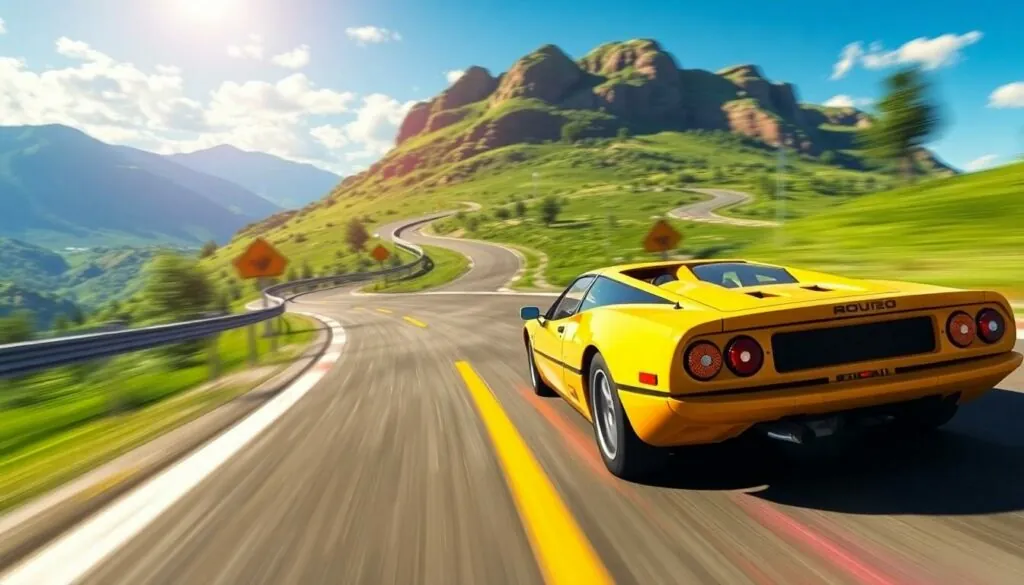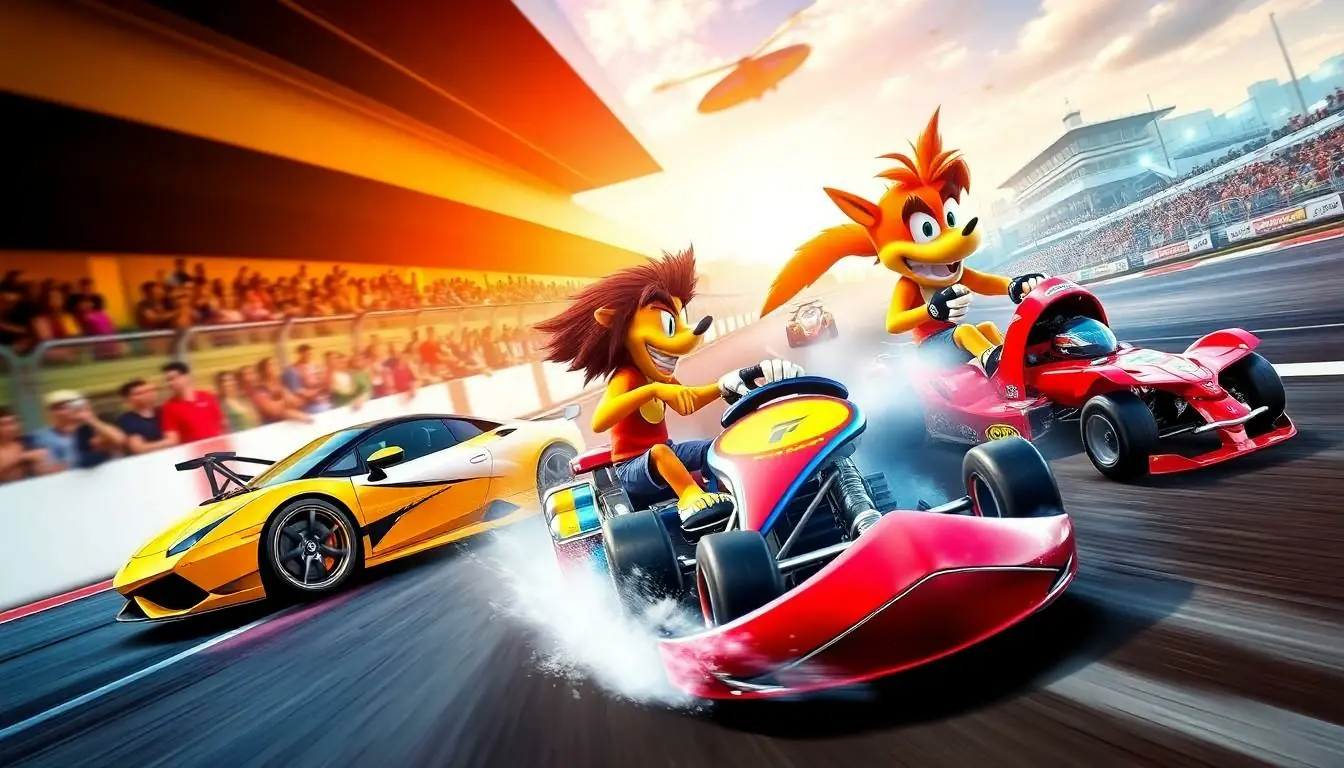Rev up those engines and dust off that classic PlayStation 1, because we’re diving into the world of racing games that defined a generation. From hairpin turns to nitrous boosts, the PS1 brought adrenaline-pumping thrills right into living rooms, all while making players feel like they were behind the wheel of a high-speed dream.
Table of Contents
ToggleOverview of Racing Games on PS1
Racing games on the PlayStation 1 pioneered a new level of immersive gameplay in the late 1990s. Nostalgic titles, such as “Gran Turismo,” captured players’ attention with realistic graphics and detailed car physics. Each game provided unique experiences, from arcade-style racing to simulations that demanded precision.
“Need for Speed” stood out with its thrilling police pursuits and street racing elements. Players felt the adrenaline rush as they evaded law enforcement while racing against opponents. “Ridge Racer,” another notable title, offered fast-paced action with drifting mechanics, appealing to those who preferred arcade-like fun.
The variety of tracks in these games contributed to their excitement. Urban environments, scenic routes, and challenging circuits kept players engaged. Multiplayer options also enhanced replay value, allowing friends to race against each other both locally and online.
Racing games on PS1 featured an impressive selection of vehicles as well. From exotic sports cars to rugged trucks, players could choose their favorites. Customization options allowed for further personalization, catering to each player’s style.
Additionally, soundtracks in these titles often featured pulse-pounding music that elevated the overall racing experience. Enthusiasts embraced the combination of thrilling gameplay and captivating audio that defined this era.
Overall, racing games on the PS1 left a lasting legacy. They influenced future developments in the genre while providing countless hours of entertainment for gamers during that time.
Iconic Racing Titles
The PlayStation 1 era featured several racing games that left a mark on gaming history. These titles captured the essence of speed, competition, and fun.
Gran Turismo
Gran Turismo revolutionized the racing genre with its realistic graphics and detailed car physics. Players experienced the thrill of driving over 150 licensed vehicles, each with unique performance attributes. The game showcased multiple tracks set in various locations, enhancing immersion. Car customization options allowed enthusiasts to modify performance and aesthetics, appealing to both casual gamers and car aficionados. Spanning over 20 tracks, Gran Turismo offered hours of gameplay. As a cornerstone in the racing genre, its influence shaped future titles and raised player expectations for realism and depth.
Crash Team Racing
Crash Team Racing combined iconic characters with high-speed kart racing. Released in 1999, it featured 16 tracks filled with vibrant graphics and dynamic environments. Gamers enjoyed diverse racing modes, including time trials and battle modes, which added variety. Collecting power-ups and utilizing unique character abilities kept races exciting. The multiplayer feature supported up to four players, promoting competitive gameplay. Notably, the game’s charming humor and engaging soundtrack solidified its status as a classic. Crash Team Racing remains a beloved title that resonates with both new players and nostalgic fans.
Ridge Racer
Ridge Racer offered an arcade-style racing experience that captivated players. Its straightforward controls and drift mechanics allowed for thrilling races across various courses. Featuring 8 tracks, each with distinct themes and challenging turns, the game showcased impressive graphics for its time. Players could choose from multiple vehicles, each designed for speed or handling. The high-energy soundtrack complemented the intense racing action, enhancing player engagement. Ridge Racer defined a generation of arcade racers and influenced numerous sequels and spin-offs. This title’s fast-paced gameplay and stylish presentation left a lasting impression.
Gameplay Mechanics and Features
Racing games on the PlayStation 1 introduced various gameplay mechanics that defined the genre. Players experienced a mix of realism and arcade-style racing across multiple titles.
Controls and Physics
Controls across PS1 racing games varied. “Gran Turismo” emphasized precision with its simulation-style driving, employing a throttle and brake system that responded realistically. Players enjoyed the feeling of acceleration and braking, making vehicle management a critical aspect. In contrast, “Ridge Racer” featured simpler controls, catering to an arcade audience with more forgiving handling. Physics in “Crash Team Racing” created a balanced racing environment, where players competed for power-ups and speed boosts. Players navigated diverse terrains, from city streets to complex tracks, enhancing engagement and requiring skillful maneuvering.
Graphics and Sound Design
Graphics in PS1 racing games showcased innovation for the time. “Gran Turismo” provided players with detailed car models, track environments, and dynamic lighting. These elements created an immersive racing atmosphere. In “Need for Speed,” night driving introduced backlit neon effects, adding to the visual appeal. Sound design played a critical role in enhancing the racing experience. Soundtracks ranged from energetic beats in “Ridge Racer” to sweeping scores in “Gran Turismo.” Engine noises, tire screeches, and environmental sounds further immersed players in the high-speed action.
The Impact of Racing Games on PS1
Racing games on the PlayStation 1 significantly shaped the gaming landscape, establishing benchmarks for realism, gameplay, and multiplayer experiences.
Influence on Future Racing Titles
Gran Turismo paved the way for realistic racing simulations, influencing titles like Forza Motorsport and Project Cars. Advanced car physics and realistic driving mechanics became standards in future games. Arcade-style games like Ridge Racer inspired other racers to adopt accessible controls and flashy graphics. Developers recognized the balance between realism and fun, shaping the vision for future racing franchises. Nostalgia for these classic titles continues to influence modern gameplay designs. Players still appreciate authentic racing experiences, prompting studios to innovate while respecting the roots laid by PS1 racing games.
Community and Multiplayer Experience
Multiplayer features expanded the social dimensions of racing games, fostering engaging competition among players. Crash Team Racing included local multiplayer modes, creating lasting friendships over heated races. Online capabilities began emerging, allowing worldwide competitions, which enhanced player interaction. Fans formed communities around titles like Gran Turismo, sharing tips and strategies for car tuning and track mastery. The excitement of competing against friends, locally or online, promoted replayability, drawing players back to their favorites. These vibrant communities remain essential to the legacy of PS1 racing games, fueling ongoing interest and engagement in the genre.
Conclusion
The legacy of racing games on the PlayStation 1 continues to resonate with gamers today. These titles not only defined a generation but also set the foundation for future developments in the racing genre. Their blend of realism and arcade fun created unforgettable experiences that still evoke nostalgia.
The community aspect fostered by local multiplayer modes remains a testament to the social connections built around these games. As players revisit these classics or discover them for the first time, the thrill of racing at high speeds and the joy of competition endure, ensuring that the impact of PS1 racing games will be felt for years to come.







